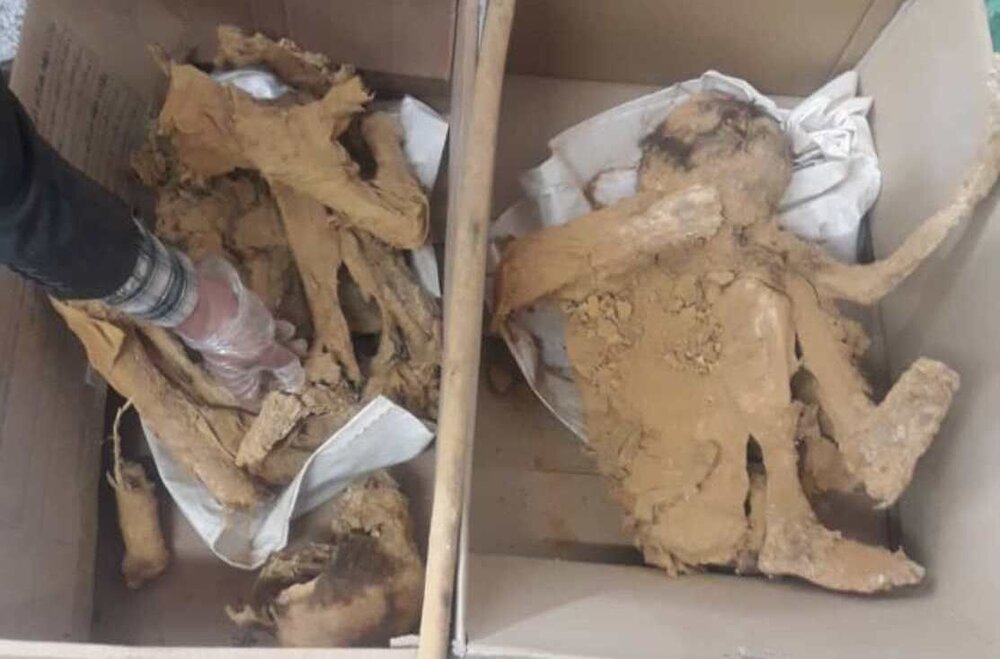Centuries-old skeletons unearthed in central Iran

TEHRAN – Two centuries-old skeletons have recently been discovered in a historical mine in the mountainous area of Ardestan county, central Isfahan province, Ardestan Governor has announced.
Mineworkers found the skeletons accidentally inside canals about 30 meters beneath the surface, IRNA quoted Hamidreza Ta’amoli as saying on Thursday.
The skeletons were immediately handed over to the Ardestan’s Cultural Heritage, Tourism and Handicrafts Department to undergo studies, the official added.
The skeletons are considered as “natural mummies” and they mark unparalleled discoveries in the history of Ardestan’s civilization, he noted.
However, detailed expert studies are needed to determine the exact age of the skeletons, he explained.
The site seems to be an abandoned zinc mine that was used in the distant past and the melting furnaces in it date back to the Safavid era (1501-1736), while the structures found in it date back to the Qajar period(1789-1925), he mentioned.
He also noted that the decorations under the roof of the old mine indicate that it is at least 600 to 1000 years old.
Discovery of exotic mummies not unprecedented in the country
The highlights of the findings in the historical mines in Iran are salt mummies. In 1993, miners in the Douzlakh Salt Mine, near Hamzehli and Chehrabad villages in Zanjan Province, accidentally came across a mummified head, dated to 300 CE. The head was very well preserved, to the extent that his pierced ear was still holding the gold earring. The hair, beard, and mustaches were reddish, and his impressive leather boot still contained parts of his leg and foot, according to the Ancient History Encyclopedia.
However, in 2004, the miners discovered yet another “saltman”, which was followed by further excavation of unearthing remains of a human body along with a large number of artifacts made of wood, metal tools, clothing, and pottery.
In 2005, a systematic excavation began, three more mummies were excavated, and a sixth remained in situ, due to lack of funds for its storage. The context of the remains suggested that a collapse in the mine had caused the death of the miners in question.
The first mummy, dubbed the “Saltman”, is on display in the National Museum of Iran in Tehran. He still looks very impressive.
This particular “saltman” was originally dated based on the archaeological material found with him. Later, the mummy was carbon dated, which placed him in 500 CE (1750 BP, that is, “before present” or 1750 years ago), the height of the Sasanian Empire. The second “saltman” was carbon-dated to 1554 BP, which placed him in the same era as the first “saltman”, the Sasanian era.
The third, fourth, and fifth “saltmen” were also carbon dated. The third body was dated and placed in 2337 BP, the fourth body in 2301 BP, and the fifth mummy was dated to 2286 BP, placing them all in the Achaemenid period.
The individual “Saltmen” have a few secrets of their own, for instance, the first “saltman” that was discovered had the blood type B+, and 3D imaging of his skull revealed fractures around his eye and other damage that occurred before death by a hard blow to the head. His clothing (the impressive leather boot) and his gold earring, show a person of some rank; the reason for his presence in the mine still remains a mystery.
Saltman No. 5 had tapeworm eggs from the Taenia sp. genus in his system. These were identified during the study of his remains. The find indicates the consumption of raw or undercooked meat, and this is the first case of this parasite in ancient Iran and the earliest evidence of ancient intestinal parasites in the area. The best preserved and probably the most harrowing of the saltmen is Saltman No. 4. A sixteen-year-old miner, caught in the moment of death, crushed by a cave-in.
ABU/AFM

Leave a Comment